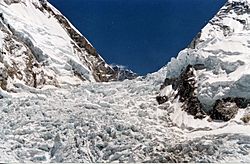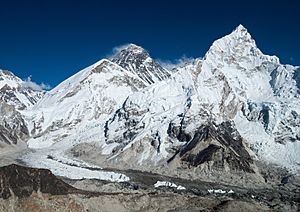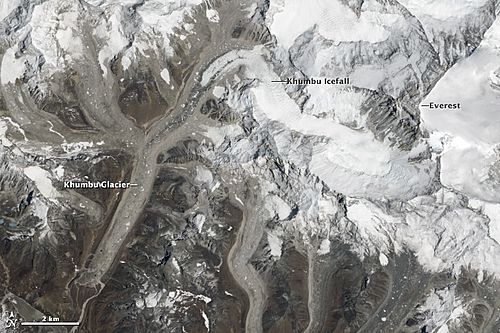2014 Mount Everest ice avalanche facts for kids

The Khumbu Icefall in 2005. The ice avalanche came from a serac fall from an ice bulge on Mount Everest's western shoulder (centre left), above the icefall.
|
|
| Date | 18 April 2014 |
|---|---|
| Time | 06:45 local time (01:00 UTC) |
| Location | Khumbu Icefall, Mount Everest |
| Cause | Avalanche |
| Deaths | 16 |
| Non-fatal injuries | 9 |
On April 18, 2014, a large piece of ice broke off from Mount Everest. This huge chunk of ice, called a serac, caused an ice avalanche. It happened in a dangerous area known as the Khumbu Icefall. Sixteen Sherpa guides were killed in this accident. Sherpas are local people who help climbers on Everest.
Thirteen bodies were found within two days. However, the other three could not be recovered. It was too dangerous to search for them. Many Sherpas were upset with the Nepalese government. They felt the money offered to victims' families was too small. On April 22, the Sherpas decided not to work on Everest for the rest of 2014. This was a way to show respect for their lost friends.
Contents
About the Guides on Mount Everest
Sherpas are very important for climbing Mount Everest. They are skilled high-altitude workers. They help set up ropes and carry supplies. A Sherpa guide can earn about $125 per day during a climb. This is a lot more than the average salary in Nepal, which is about $700 a year. Many Sherpas come from families who have always worked in climbing. There are not many other ways to earn a good living in their region. Each year, between 350 and 450 Sherpas work during the climbing season.
In the years before this accident, some foreign climbers started bringing their own guides. This caused some arguments with the local Sherpas. In 2013, eight people died on Mount Everest. One of them was a very experienced Sherpa guide.
Dangers of the Khumbu Icefall Route
The Khumbu Icefall is a very risky part of the climb. It has many unstable blocks of ice called seracs. Climbers try to get through it as fast as possible. They usually go early in the morning when the ice is colder and more stable.
In 2012, a climbing company called Himex stopped its climbs. Their leader, Russell Brice, was worried about a large ice cliff. This cliff was on Mount Everest's western side. If it fell, it could hit the route through the Khumbu Icefall. He said, "When I see around 50 people moving underneath the cliff at one time, it scares me." Even so, Himex returned to Everest for the 2014 season.
Mountaineer Alan Arnette said this ice bulge had been a known danger for years. He noted it often dropped ice into the Khumbu Icefall. He added that in 2012, it "narrowly missed many climbers." Writer Jon Krakauer said the 2014 ice avalanche happened when a piece of ice "the size of a Beverly Hills mansion" broke off.
The glacier's ice is always moving. This means climbing guides must find a new, safe path through the icefall every year.
The Ice Avalanche Event
At about 6:45 AM local time on April 18, 2014, the ice avalanche happened. It was on the southern side of Mount Everest. The location was about 5,800 meters (19,000 feet) high. Twenty-five men were caught in the avalanche. Most of them were Sherpas. They were setting up ropes for climbers. They were also preparing the South Col route for the upcoming climbing season. The accident area is known as "the Golden Gate" or "Popcorn Field." It is inside the Khumbu Icefall.
The ice avalanche was caused by a huge serac breaking off. This serac was on the western side of Mount Everest. It was not like a typical snow avalanche. Instead, large blocks of ice fell, similar to a rockfall. The serac was estimated to be 34.5 meters (113 feet) thick. It weighed about 14,300 tonnes (31.5 million pounds). Some people have suggested building barriers to prevent such events. However, such structures would be impossible to build for an event of this size.
Victims of the Disaster
| Victims |
|---|
| Mingma Nuru Sherpa |
| Dorji Sherpa |
| Ang Tshiri Sherpa |
| Nima Sherpa |
| Phurba Ongyal Sherpa |
| Lakpa Tenjing Sherpa |
| Chhiring Ongchu Sherpa |
| Dorjee Khatri |
| Then Dorjee Sherpa |
| Phur Temba Sherpa |
| Pasang Karma Sherpa |
| Asman Tamang |
| Tenzing Chottar Sherpa |
| Ankaji Sherpa |
| Pem Tenji Sherpa |
| Ash Bahadur Gurung |
Sixteen people died in this disaster. Thirteen bodies were found within two days. Search and rescue efforts were stopped because it was too risky. Three victims are still buried under 80 to 100 meters (260 to 330 feet) of snow and ice. Nine other guides were hurt. Three of them needed serious hospital care.
Four of the Sherpas who died were from Nepal's Solukhumbu District. Five were working for Discovery Channel. They were preparing for a TV show where Joby Ogwyn planned to try a BASE jump from the mountain. No foreign climbers were killed.
Mountaineer Tim Rippel said the victims were moving slowly. They were carrying heavy loads of equipment. This included tents, stoves, and oxygen. They were taking these supplies to higher camps. The Sherpas had started early in the morning. But bad climbing conditions had delayed them. The film crew for the movie Everest was filming nearby. They were not hurt. Sherpas working on the film helped with the rescue. The rescue team included nine Sherpas and three foreigners.
This 2014 disaster was the second deadliest in Everest's history. The worst happened the next year, in 2015. Avalanches struck the mountain after a big earthquake in Nepal.
Reactions to the Avalanche
Tim Rippel reported that "everyone is shaken here at base camp." Some climbers immediately packed up and left.
The Nepalese government offered 40,000 Nepali Rupees ($400) to the families of the victims. This money was meant to help with funeral costs. However, the Sherpas and the Nepal Mountaineering Association (NMA) were angry. They felt it was not enough. The NMA demanded $10,000 for each family. They also wanted a memorial for the dead. They asked for insurance coverage to be doubled to $20,000. They also wanted the government to pay for medical bills.
Reports said that 350 guides voted to stop all climbing on Everest. Other reports said they agreed to "strong protests." On April 21, eight of the dead were honored in a ceremony in Kathmandu. They were then cremated in a Buddhist religious ceremony.
On April 22, the Sherpas announced they would not work on Everest for the rest of 2014. This was to honor their lost friends. Tulsi Gurung said, "All Sherpas are united in this." It was unclear what would happen to the 334 climbing permits. Each permit cost $10,000. By April 24, almost all climbing groups had decided to leave. The number of mountaineers at Base Camp dropped from 600 to about 40 or 50.
On April 23, the Nepalese government offered more money. They would give an extra 500,000 Nepali Rupees (about $5,100) to the families. These funds started to be paid in December 2014. But in January 2015, families were still upset. They had to go to Kathmandu to get the money. This was hard for many who lived in the Khumbu region.
Discovery Channel canceled Joby Ogwyn's planned BASE jump. Instead, they decided to show a documentary about the tragedy. The 90-minute show, called Everest Avalanche Tragedy, aired on May 4. The company also donated money to a charity. This charity supports the families of those who died.
After the accident, the NMA president, Ang Tsering Sherpa, suggested building barriers. These barriers would be like those used in European ski resorts. They would help prevent avalanches. However, it is very hard to build such structures for events of this size.
The 2015 documentary Sherpa explores what happened after the avalanche. The filmmakers were there when it occurred.
Aftermath and Changes
| Year | Summiters | Reference(s) |
|---|---|---|
| 2012 | 547 | |
| 2013 | 658 | |
| 2014 | 106 | |
| 2015 | 0 | |
| 2016 | 641 | |
| 2017 | 648 | |
| 2018 | 801 |
Climbs After the Avalanche in 2014
The first person to climb Mount Everest after the avalanche was Wang Jing. She was a businesswoman from China. She reached the top on May 23, 2014. Five Sherpas helped her. Her climb caused some debate. She used a helicopter to fly over the Khumbu Icefall. This was because the ropes and ladders had been removed after the disaster. She climbed without new ropes. She also went past the usual cut-off time of 2 PM. She came down in the dark. Tamding Sherpa, who was supposed to guide her, called her climb "cheating."
Changes Made in 2015
Because the old route through the icefall was so dangerous, changes were made. In February 2015, Nepali officials announced a new route. This new path would go through the center of the icefall. Tulasi Prasad Gautam, a government official, said, "We are trying to make Everest climbing a little safer by avoiding the old route."
Also, the insurance for each Sherpa was increased. It went from $11,000 to $15,000 in 2015.
See also
 In Spanish: Avalancha del monte Everest de 2014 para niños
In Spanish: Avalancha del monte Everest de 2014 para niños
- List of deaths on eight-thousanders
- List of people who died climbing Mount Everest
- 1970 Mount Everest disaster
- Sherpa (film)




